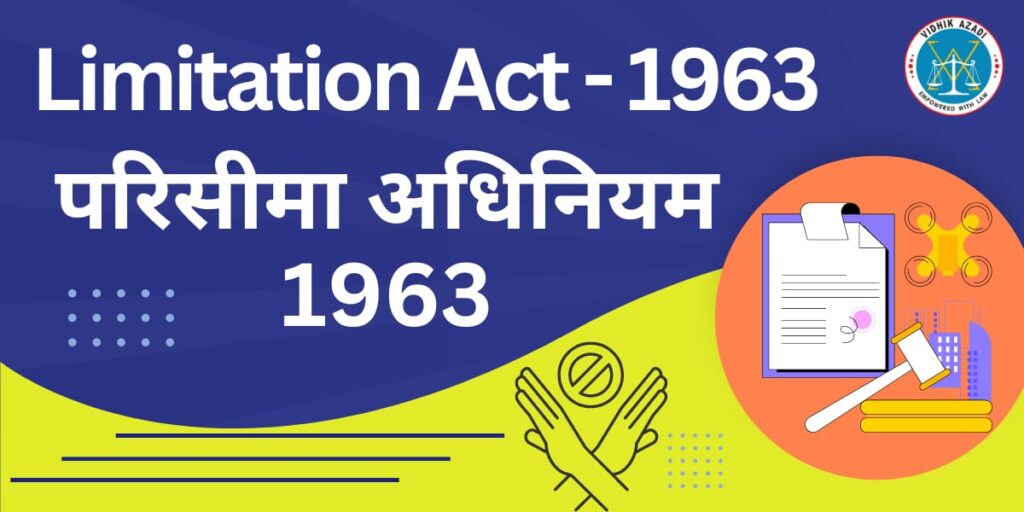Indian Limitation Act

Limitation Act 1963
The Limitation Act of 1963 is an Indian legislation that prescribes the time limits within which legal actions can be initiated in civil cases. The primary objective of the Act is to ensure that litigation is initiated within a reasonable time frame, thereby preventing undue delay and ensuring legal certainty. The Act specifies different limitation periods for different kinds of suits, appeals, and applications. These time limits are generally counted from the date when the cause of action arises. For instance, the limitation period for filing a suit for the recovery of land is 12 years, while for debts and contracts, it is 3 years.
The period of limitation is calculated from the day the right to sue accrues. Certain exceptions exist, such as when the claimant is a minor, insane, or imprisoned, which can extend the limitation period. The Act allows for the extension of the limitation period under specific circumstances, such as if the defendant is absent from India or if there is a delay in obtaining a copy of a judgement or order required for an appeal. Certain periods are excluded from the calculation, like the time during which the court was closed or the time taken to obtain essential documents.
If a suit, appeal, or application is filed after the expiration of the prescribed period, it will be dismissed. The law emphasizes that no right to initiate legal action exists beyond this period, barring certain exceptional situations. A fresh limitation period can start if there is an acknowledgment of the debt or liability in writing before the expiration of the original limitation period. Similarly, part-payment of the debt or interest before the limitation period expires can also renew the limitation period. Provisions are made for those under legal disability (e.g., minors, individuals with unsound mind). In such cases, the limitation period begins once the disability ceases. For continuing breaches of contract or tort, the limitation period is calculated from the date of the last occurrence of the breach or wrong.
The Limitation Act, 1963 aims to encourage diligence and promptness in the prosecution of legal claims. Prevent the revival of stale claims, ensuring that evidence and facts are recent and more likely to be reliable and bring certainty and finality to disputes. The Limitation Act, 1963 sets definitive time limits for filing various types of civil cases, ensuring that claims are made while evidence is still fresh and available. It includes provisions for extending, computing, and excluding time under specific circumstances, thus providing a structured framework for the timely administration of justice.
सीमांकन अधिनियम, 1963
सीमांकन अधिनियम, 1963 (Limitation Act, 1963) भारत का एक प्रमुख विधि है, जो दीवानी मामलों में वाद दायर करने की समय सीमाएं निर्धारित करता है। इस अधिनियम का मुख्य उद्देश्य यह सुनिश्चित करना है कि कानूनी कार्यवाही एक उचित समय सीमा के भीतर शुरू की जाए, जिससे अनावश्यक देरी रोकी जा सके और विधिक निश्चितता सुनिश्चित हो सके। यह अधिनियम विभिन्न प्रकार के वाद, अपील और आवेदन के लिए अलग-अलग समय सीमाएं निर्धारित करता है। यह समय सीमाएं आमतौर पर उस तारीख से गिनी जाती हैं, जब कारण कार्रवाई उत्पन्न होता है। उदाहरण के लिए, भूमि की वसूली के लिए वाद दायर करने की समय सीमा 12 वर्ष है, जबकि ऋण और अनुबंध के लिए यह 3 वर्ष है। सीमांकन अवधि उस दिन से गिनी जाती है जब वाद का अधिकार उत्पन्न होता है। कुछ अपवाद भी हैं, जैसे कि यदि वादी नाबालिग, पागल या कैद में है, तो समय सीमा बढ़ाई जा सकती है।
अधिनियम विशिष्ट परिस्थितियों में सीमांकन अवधि के विस्तार की अनुमति देता है, जैसे कि यदि प्रतिवादी भारत से बाहर है या यदि अपील के लिए आवश्यक आदेश या निर्णय की प्रति प्राप्त करने में देरी होती है। कुछ अवधियों को गणना से बाहर रखा गया है, जैसे कि जब न्यायालय बंद था या आवश्यक दस्तावेज प्राप्त करने में समय लगा। यदि वाद, अपील या आवेदन निर्धारित समय सीमा समाप्त होने के बाद दायर किया जाता है, तो इसे खारिज कर दिया जाएगा। यह कानून जोर देता है कि इस अवधि के बाद कानूनी कार्रवाई का कोई अधिकार नहीं है, कुछ अपवादों को छोड़कर।
यदि सीमांकन अवधि समाप्त होने से पहले ऋण या दायित्व की लिखित में स्वीकृति होती है, तो एक नई सीमांकन अवधि शुरू हो सकती है। इसी प्रकार, ऋण या ब्याज का आंशिक भुगतान सीमांकन अवधि समाप्त होने से पहले नई अवधि शुरू कर सकता है। जो लोग कानूनी विकलांगता (जैसे नाबालिग, पागल व्यक्ति) के अधीन हैं, उनके लिए प्रावधान किए गए हैं। इन मामलों में, सीमांकन अवधि तब शुरू होती है जब विकलांगता समाप्त होती है। निरंतर अनुबंध या कष्ट के उल्लंघन के मामलों में, सीमांकन अवधि अंतिम उल्लंघन या गलती की तारीख से गिनी जाती है।
सीमांकन अधिनियम, 1963 का उद्देश्य कानूनी दावों के निष्पादन में सतर्कता और तत्परता को प्रोत्साहित करना, पुराने दावों को पुनर्जीवित करने से रोकना, जिससे सबूत और तथ्य ताजा और विश्वसनीय बने रहें तथा विवादों में निश्चितता और अंतिमता लाना है। सीमांकन अधिनियम, 1963 विभिन्न प्रकार के दीवानी मामलों के लिए निश्चित समय सीमाएं निर्धारित करता है, जिससे यह सुनिश्चित होता है कि दावे उस समय तक किए जाएं जब तक सबूत ताजा और उपलब्ध हों। यह विशिष्ट परिस्थितियों में समय के विस्तार, गणना और अपवर्जन के प्रावधान भी शामिल करता है, जिससे न्यायिक कार्यवाही की समयबद्धता सुनिश्चित होती है।
